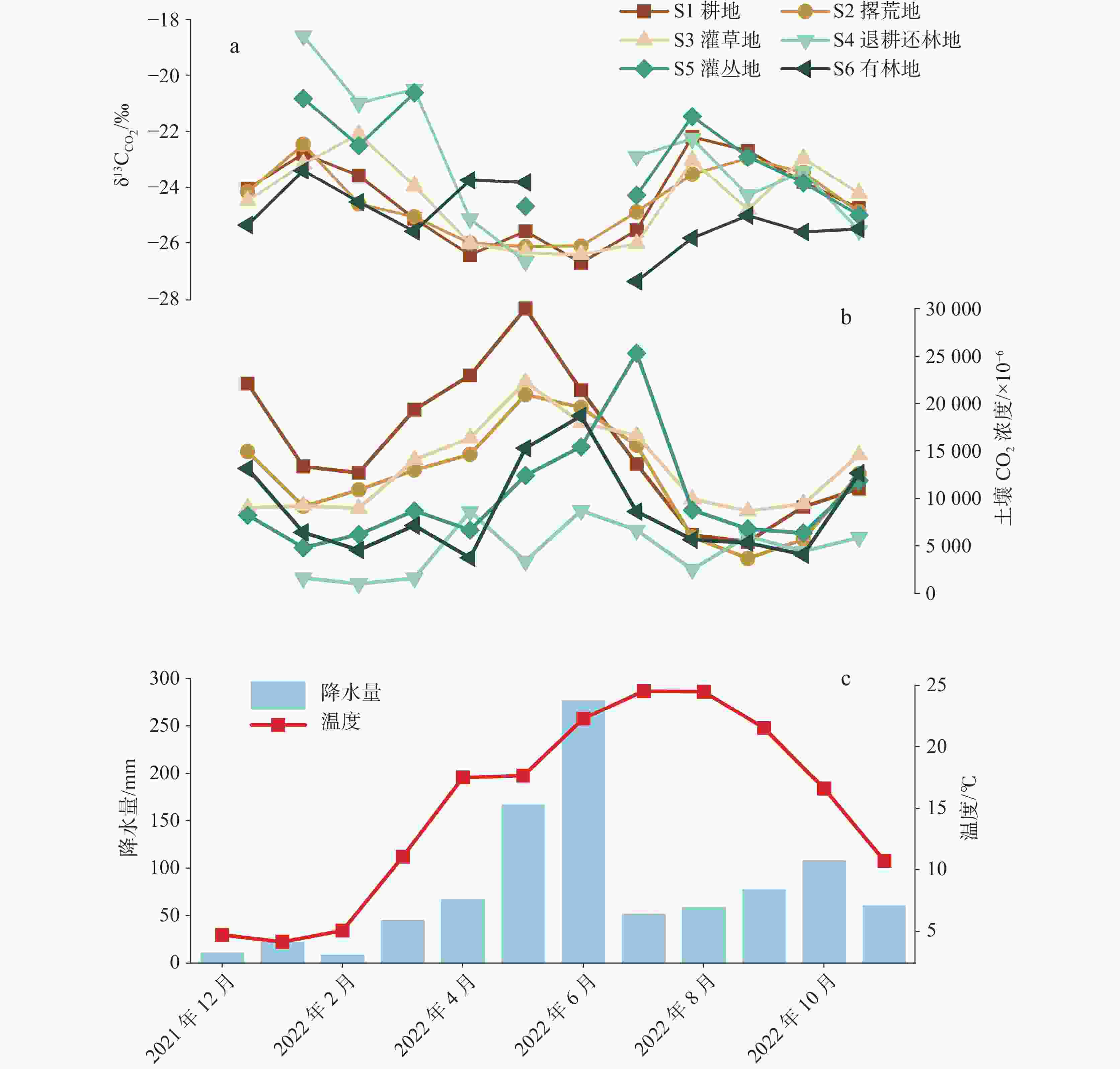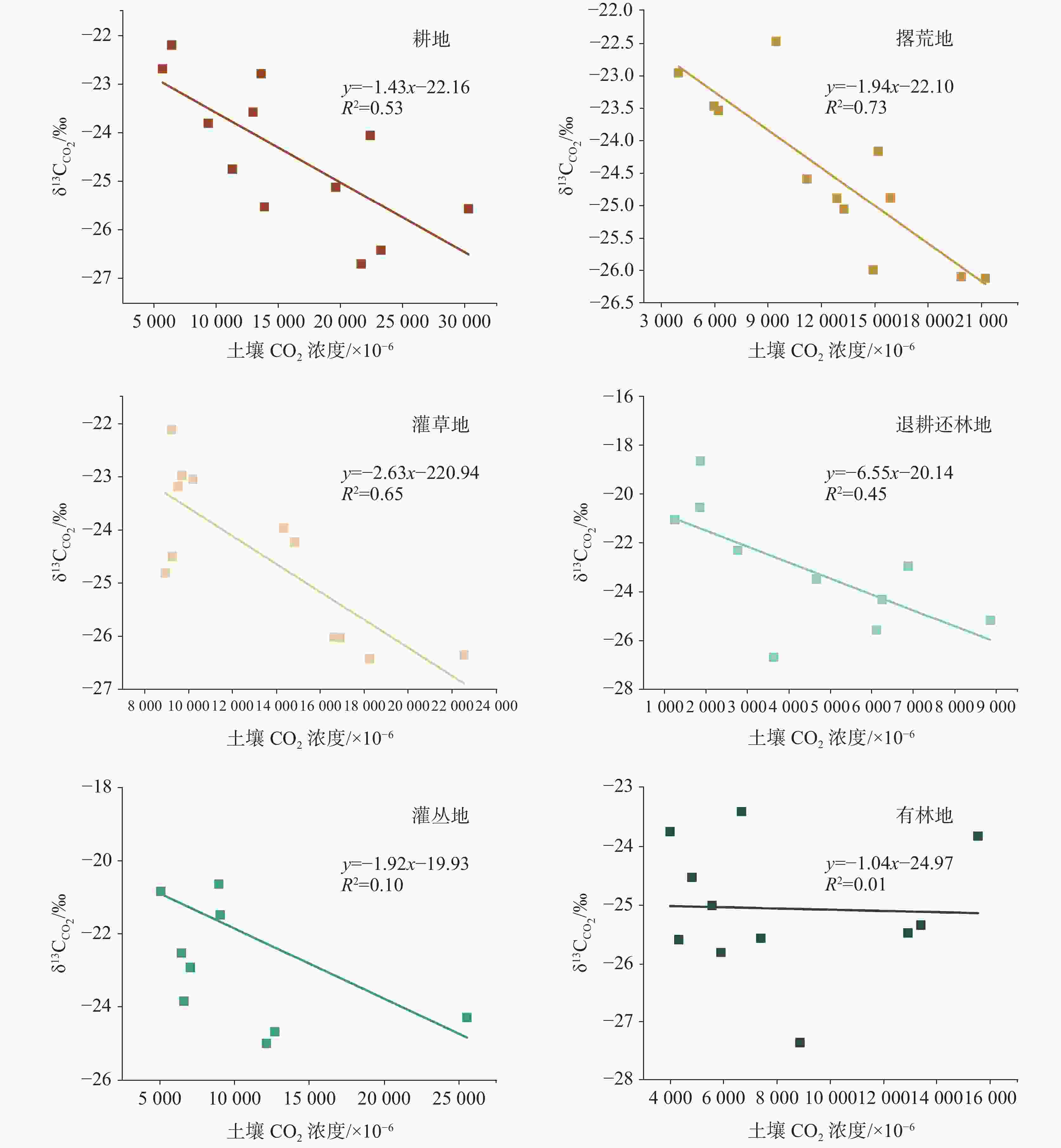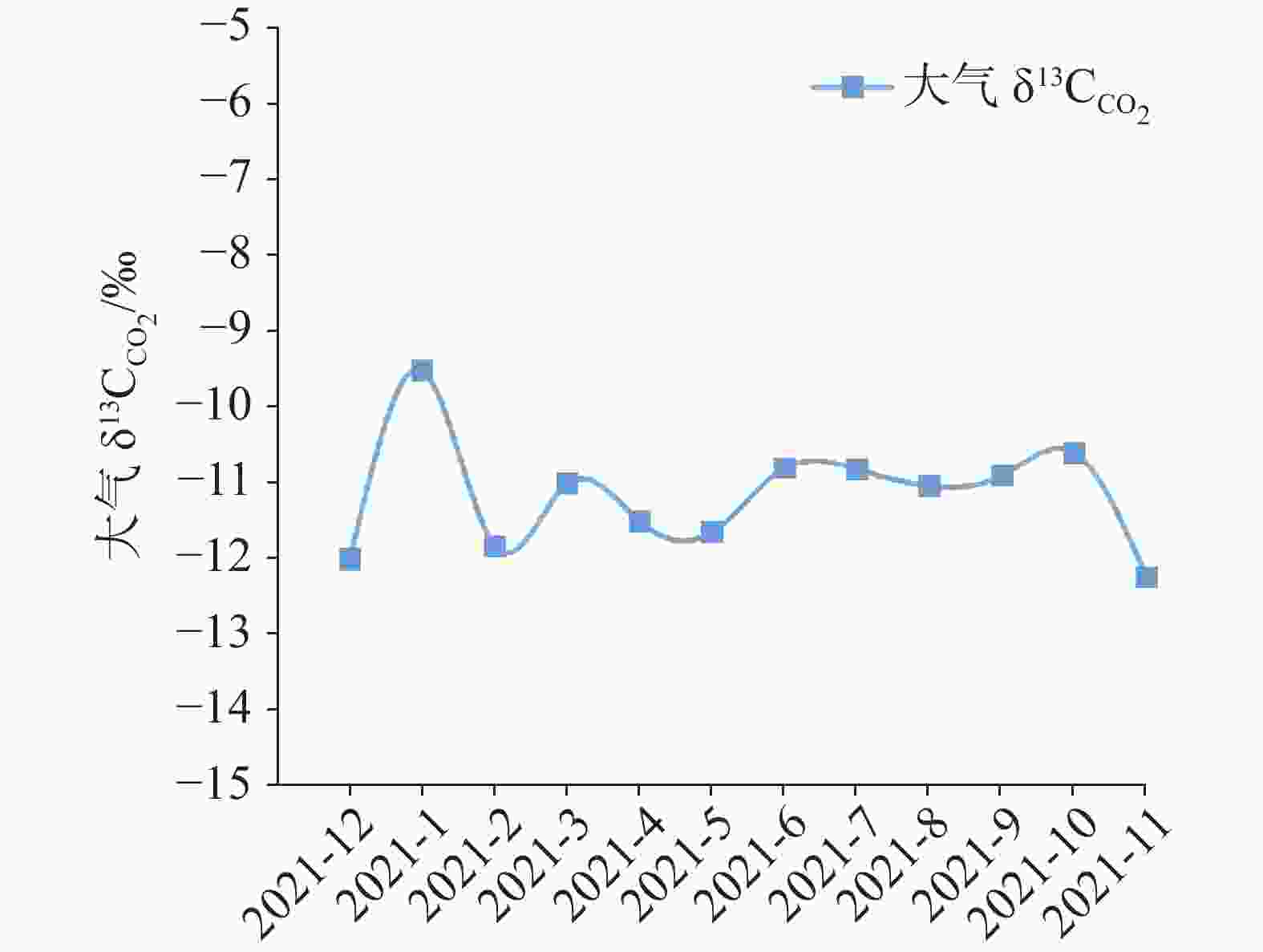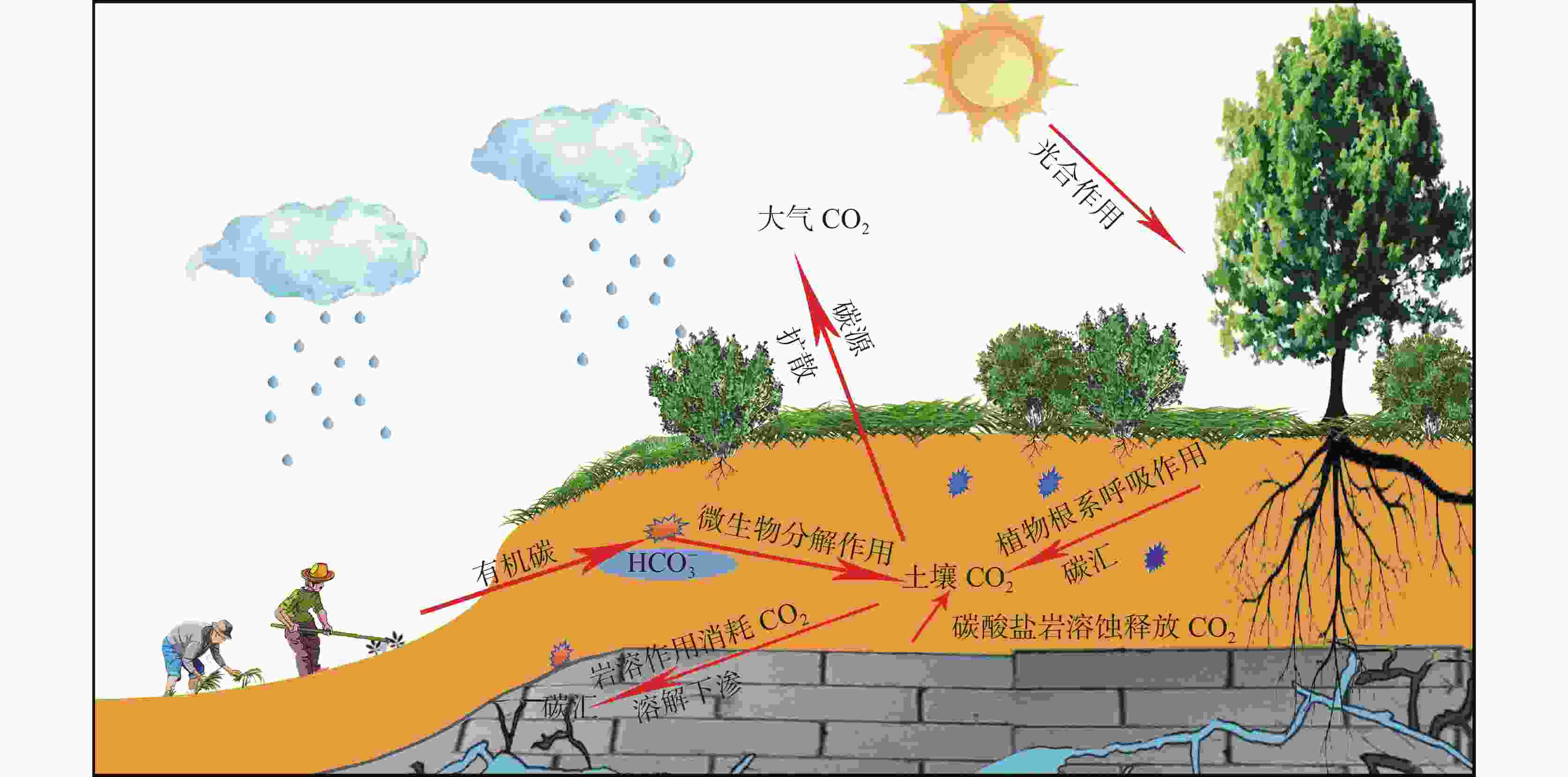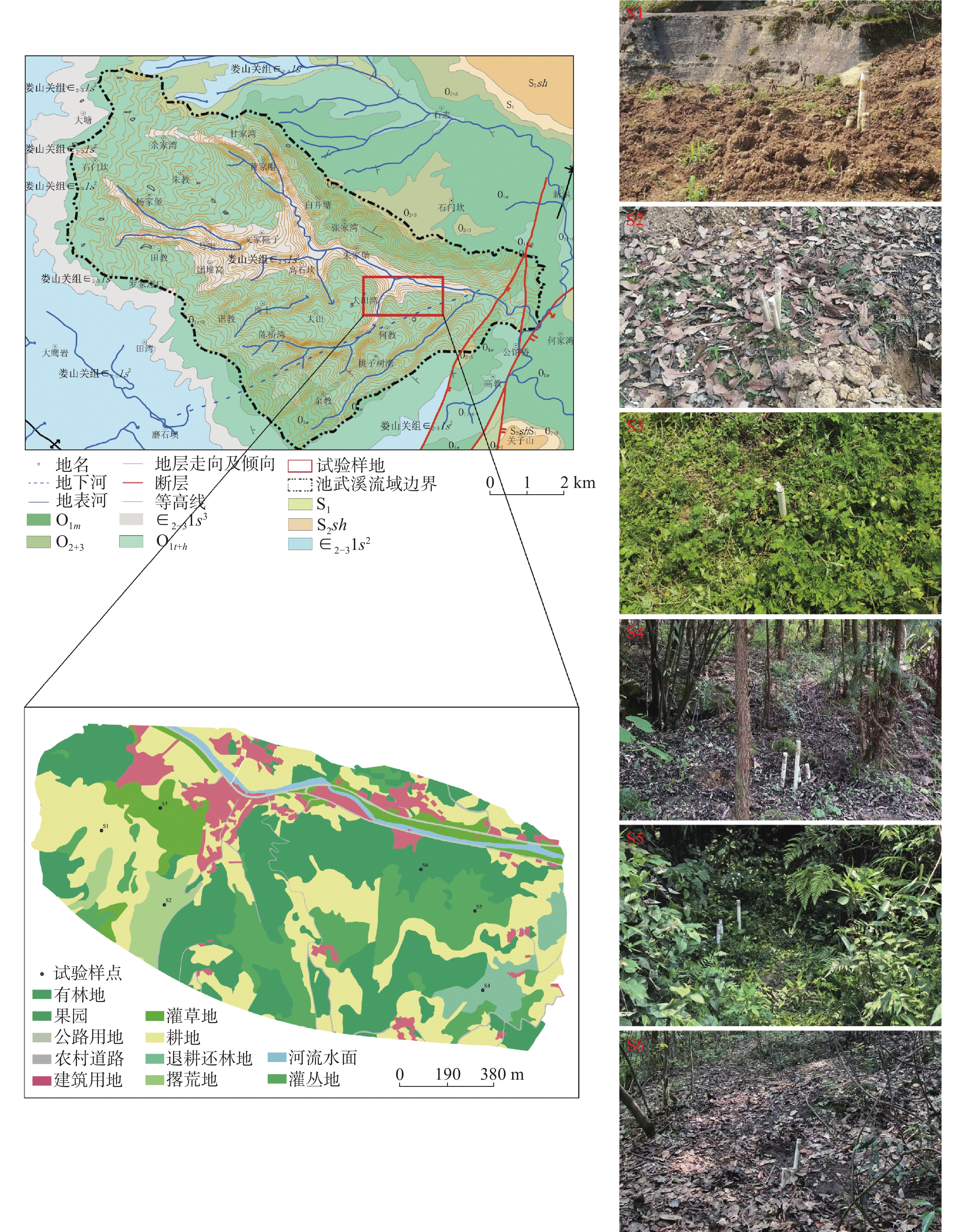Temporal and spatial variations of soil CO2 and δ13${\mathrm{C}}_{{\mathrm{CO}}_2} $ from different land uses in typical dolomite areas of Southwest China
-
摘要: 为探究典型白云岩地区不同土地利用的土壤CO2及δ13$ {\rm{C}}_{{\rm{CO}}_2} $的时空差异和影响因素,厘清白云岩地区土壤碳循环的机理,文章选取中国西南典型白云岩地区——双河洞国家地质公园为研究对象,对园内不同土地利用类型的土壤CO2及其δ13$ {\rm{C}}_{{\rm{CO}}_2} $进行为期一年的监测,并运用数理统计方法进行系统分析。结果表明:(1)不同土地利用类型土壤CO2浓度表现为:耕地>灌草地>撂荒地>灌丛地>有林地>退耕还林地,土壤温度和含水量、上覆植被、有机碳和人类活动等是影响其变化的重要因素;(2)不同土地利用类型土壤δ13$ {\rm{C}}_{{\rm{CO}}_2} $表现为:灌丛地>退耕还林地>耕地>灌草地>撂荒地>有林地。土壤12C和13C的扩散率、有机碳的分解转换及同位素分馏作用、植物光合作用和碳酸盐岩溶蚀等存在差异导致土壤δ13$ {\rm{C}}_{{\rm{CO}}_2} $变化;(3)时间变化上,不同土地利用类型土壤CO2浓度均呈现出雨季高旱季低的变化特征,土壤δ13$ {\rm{C}}_{{\rm{CO}}_2} $则呈现相反的季节变化特征。土壤有机物氧化分解、微生物的代谢活动、植物根系呼吸作用及碳酸盐岩溶蚀作用是研究区土壤CO2的主要来源。Abstract:
Shuanghedong national geopark is a prominent example of dolomite on a global scale. Soil CO2 in the dolomite areas is an important driving force of karstification and has great significance for the global carbon cycle. However, the mechanism of soil carbon cycle in dolomite areas has yet to be clarified. In order to investigate the spatial and temporal variations and influencing factors of soil CO2 and δ13$ {\rm{C}}_{{\rm{CO}}_2} $ in different land uses in typical dolomite areas and to clarify the mechanism of soil carbon cycle in these areas, this study selected Shuanghedong National Geopark, a typical dolomite area in Southwest China, as the study area. Soil CO2 and δ13$ {\rm{C}}_{{\rm{CO}}_2} $ were sampled from six typical land use types in Shuanghedong national geopark. These samples were monitored outdoors and subjected to laboratory experiments over the course of one year. Additionally, the data were systematically analyzed with mathematical and statistical methods. The study results indicate as follows, (1) Soil CO2 concentrations of different land use types were observed in the following order: cropland>irrigation grassland>abandoned land>scrubland>forested land>fallow land. Soil temperature and water content, overlying vegetation, organic carbon, and human activities were important factors influencing the changes of soil CO2 in different land use types. (2) The values of soil δ13$ {\rm{C}}_{{\rm{CO}}_2} $ of different land use types were ranked as follows, scrubland>fallow land>cropland>irrigation grassland>abandoned land>forested land. Differences in diffusion rates of soil 12C and 13C, decompositional conversion of organic carbon and isotopic fractionation, plant photosynthesis and carbonate rock dissolution led to changes of soil δ13$ {\rm{C}}_{{\rm{CO}}_2} $ in different land use types. (3) In terms of temporal changes, soil CO2 concentrations of different land use types were high in the rainy season and low in the dry season, while concentrations of soil δ13$ {\rm{C}}_{{\rm{CO}}_2} $ exhibited opposite seasonal patterns, showing small values in the rainy season and large in the dry season. Oxidative decomposition of soil organic matter, metabolic activities of microorganisms, respiration of plant roots and dissolution of carbonate rocks are the main sources of soil CO2 in dolomite areas. Therefore, oxidation and decomposition of organic matter, dissolution of carbonate rocks, photosynthesis of plants, and metabolism of microorganisms store part of CO2 in soil to form carbon sinks. The other part of soil CO2 in the dolomite area are primarily attributed to the higher partial pressure of soil CO2 compared to that in the atmosphere. This difference in pressure facilitates diffusion, allowing CO2 to escape into the atmosphere as a carbon source. In addition, the study also indicates that different land use types, soil temperature, water content, overlying vegetation, human activities, and organic carbon all influence the intensity of carbon sources and carbon sinks in the soil carbon cycle in dolomite areas to varying degrees. The research findings have deepened the understanding of soil CO2 in dolomite areas of northern Guizhou, revealed the spatiotemporal differences and influencing factors of soil CO2 and δ13$ {\rm{C}}_{{\rm{CO}}_2} $ in different land use types, clarified the mechanism of soil carbon cycle in typical dolomite areas, and provided a reference for the study of soil carbon cycle in these areas. -
表 1 雨季、旱季土壤CO2和δ13${\rm{C}}_{{\rm{CO}}_2} $与土壤含水量和土壤温度的相关性
Table 1. Correlations of soil CO2 and δ13${\rm{C}}_{{\rm{CO}}_2} $ with soil water content and soil temperature during the rainy and dry season
变量 土壤温度 土壤含水量 雨季 旱季 雨季 旱季 土壤CO2 0.821** 0.551** 0.494** 0.282 土壤δ13${\rm{C}}_{{\rm{CO}}_2} $ −0.505* −0.287 −0.078 −0.521* 注:*表示在0.05的显著水平下显著;**表示在0.01的显著水平下显著。
Note:* indicates significant at the level of 0.05; ** indicates significant at the level of 0.01.表 2 不同土地利用类型监测点基本情况
Table 2. Basic situation of monitoring sites of different land use types
土地类型 编号 海拔/m 植被类型 植被盖度/% 土壤根系情况 SOC/mg·kg−1 耕地 S1 962 玉米 43 极少根系 6790 撂荒地 S2 850 杂草 28 少量根系 3316 灌草地 S3 760 次生小灌木杂草 56 少量细小根系 3649 退耕还林地 S4 774 人工针叶林 59 少量根系 1086 灌丛地 S5 735 灌木杂草 67 含大量根系 2533 有林地 S6 687 天然高大乔木 82 根系较多 4138 -
[1] Yuan D X. Foreword for the special topic "Geological Processes in Carbon Cycle"[J]. Chinese Science Bulletin, 2011, 56(35): 3741-3742. [2] 田娜, 王义祥, 翁伯琦. 土壤碳储量估算研究进展[J]. 亚热带农业研究, 2010, 6(3):193-198. doi: 10.3969/j.issn.1673-0925.2010.03.011TIAN Na, WANG Yixiang, WENG Boqi. Advances in estimating soil carbon storage[J]. Subtropical Agriculture Research, 2010, 6(3): 193-198. doi: 10.3969/j.issn.1673-0925.2010.03.011 [3] 王忆慧, 龚吉蕊, 刘敏, 黄永梅, 晏欣, 张梓瑜, 徐沙, 罗亲普. 草地利用方式对土壤呼吸和凋落物分解的影响[J]. 植物生态学报, 2015, 39(3):239-248. doi: 10.17521/cjpe.2015.0023WANG Yihui, GONG Jirui, LIU Min, HUANG Yongmei, YAN Xin, ZHANG Ziyu, XU Sha, LUO Qinpu. Effects of grassland-use on soil respiration and litter decomposition[J]. Chinese Journal of Plant Ecology, 2015, 39(3): 239-248. doi: 10.17521/cjpe.2015.0023 [4] 蒋忠诚, 章程, 罗为群, 肖琼, 吴泽燕. 我国岩溶地区碳汇研究进展与展望[J]. 中国岩溶, 2022, 41(3):345-355. doi: 10.11932/karst20220302JIANG Zhongcheng, ZHANG Cheng, LUO Weiqun, XIAO Qiong, WU Zeyan. Research progress and prospect of carbon sink in karst region of China[J]. Carsologica Sinica, 2022, 41(3): 345-355. doi: 10.11932/karst20220302 [5] 吴夏, 潘谋成, 殷建军, 汪智军, 朱晓燕, 杨会, 曹建华. 桂林典型岩溶区土壤CO2通量及其δ13 ${\rm{C}}_{{\rm{CO}}_2} $季节性特征[J]. 中国岩溶, 2021, 40(4):592-599.WU Xia, PAN Moucheng, YIN Jianjun, WANG Zhijun, ZHU Xiaoyan, YANG Hui, CAO Jianhua. Seasonal variation characteristics of soil respiration release and its isotopic composition in typical karst area, Guilin[J]. Carsologica Sinica, 2021, 40(4): 592-599. [6] 刘再华, 何师意, 袁道先, 赵景波. 土壤中的CO2及其对岩溶作用的驱动[J]. 水文地质工程地质, 1998(4):44-47. [7] 赵瑞一, 吕现福, 蒋建建, 段逸凡. 土壤CO2及岩溶碳循环影响因素综述[J]. 生态学报, 2015, 35(13):4257-4264.ZHAO Ruiyi, LÜ Xianfu, JIANG Jianjian, DUAN Yifan. Factors affecting soil CO2 and karst carbon cycle[J]. Acta Ecologica Sinica, 2015, 35(13): 4257-4264. [8] 殷超, 周忠发, 田衷珲, 曹明达, 张结, 潘艳喜, 汪炎林. 土壤CO2与喀斯特洞穴CO2季节变化响应分析[J]. 水土保持学报, 2017, 31(4):304-310.YIN Chao, ZHOU Zhongfa, TIAN Zhonghui, CAO Mingda, ZHANG Jie, PAN Yanxi, WANG Yanlin. Seasonal response between soil CO2 and karst cave CO2 concentration[J]. Journal of Soil and Water Conservation, 2017, 31(4): 304-310. [9] Raich J W, Schlesinger W H. The global carbon dioxide flux in soil respiration and its relationship to vegetation and climate[J]. Tellus, 1992, 44(2): 81-99. [10] Raich J W, Potter C S, Bhagawati D. Interannual variability in global soil respiration, 1980−94[J]. Global Change Biology, 2010, 8(8): 800-812. [11] Yakov Kuzyakov, Alla A Larionova. Root and rhizomicrobial respiration: A review of approaches to estimate respiration by autotrophic and heterotrophic organisms in soil[J]. Journal of Plant Nutrition and Soil Science, 2005, 168(4): 503-520. [12] Gaudinski J B, Trumbore S E. Soil carbon cycling in a temperate forest: Radiocarbon-based estimates of residence times, sequestration rates and partitioning of fluxes[J]. Biogeochemistry, 2000, 51(1): 33-69. doi: 10.1023/A:1006301010014 [13] 郑乐平. 黔中岩溶地区土壤CO2的稳定碳同位素组成研究[J]. 中国科学(D辑), 1999, 29(6):514-519. [14] Bird M I, Haberle S G, Chivas A R. Effect of altitude on the carbon-isotope composition of forest and grassland soils from Papua New Guinea[J]. Global Biogeochemical Cycles, 1994, 8(1): 13-22. doi: 10.1029/93GB03487 [15] 丁梦凯, 胡晓农, 曹建华, 吴夏, 黄芬, 王奇岗, 闵佳. 桂林毛村不同土地利用方式下土壤呼吸空间变异特征[J]. 环境科学, 2019, 40(2):924-933.DING Mengkai, HU Xiaonong, CAO Jianhua, WU Xia, HUANG Fen, WANG Qigang, MIN Jia. Spatial variability in soil respiration under different land use patterns in Maocun village, Guilin[J]. Environmental Science, 2019, 40(2): 924-933. [16] 李涛, 吴夏, 黄艳梅, 陈家瑞, 张美良, 朱晓燕. 桂林岩溶土壤和植被的稳定碳同位素组成及季节性性变化特征[J]. 南方农业学报, 2013, 44(6):968-973.LI Tao, WU Xia, HUANG Yanmei, CHEN Jiarui, ZHANG Meiliang, ZHU Xiaoyan. Stable carbon isotopic composition and seasonal varying characteristics of karst soil and vegetation in Guilin[J]. Journal of Southern Agriculture, 2013, 44(6): 968-973. [17] 丁平, 沈承德, 王宁, 易惟熙, 丁杏芳, 付东坡, 刘克新, 赵平. 鼎湖山季风常绿阔叶林土壤CO2气体碳同位素组成、更新特征及来源比例[J]. 科学通报, 2010, 55(9):779-787. [18] 赵瑞一, 李建鸿, 董莉莉, 刘畅, 张灵艺. 不同土地利用类型下岩溶泉域土壤CO2时空变化特征及来源分析[J]. 生态环境学报, 2020, 29(1):81-87.ZHAO Ruiyi, LI Jianhong, DONG Lili, LIU Chang, ZHANG Lingyi. Spatio-temporal variation characteristics and source of soil CO2 in karst spring catchments under different land use types[J]. Ecology and Environmental Sciences, 2020, 29(1): 81-87. [19] 刘再华. 碳酸盐岩岩溶作用对大气CO2沉降的贡献[J]. 中国岩溶, 2000, 19(4):293-300. doi: 10.3969/j.issn.1001-4810.2000.04.001LIU Zaihua. Contribution of carbonate rock weathering to the atmospheric CO2 sink[J]. Carsologica Sinica, 2000, 19(4): 293-300. doi: 10.3969/j.issn.1001-4810.2000.04.001 [20] 李大通, 罗雁. 中国碳酸盐岩分布面积测量[J]. 中国岩溶, 1983, 2(2):147-150.LI Datong, LUO Yan. Measurement of carbonate rocks distribution area in China[J]. Carsologica Sinica, 1983, 2(2): 147-150. [21] 闫伟, 曾成, 肖时珍, 蓝家程, 代林玉, 邰治钦, 何江湖, 何春, 狄永宁. 湿润亚热带典型白云岩流域不同土地利用下的试片溶蚀速率及岩溶碳汇[J]. 地球与环境, 2021, 49(5):529-538.YAN Wei, ZENG Cheng, XIAO Shizhen, LAN Jiacheng, DAI Linyu, TAI Zhiqin, HE Jianghu, HE Chun, DI Yongning. Dissolution rate and karst carbon sink of different land use in typical dolomite watershed with humid subtropical weather[J]. Earth and Environment, 2021, 49(5): 529-538. [22] 代林玉, 肖时珍, 曾成, 闫伟, 肖华, 邰治钦. 湿润亚热带典型白云岩区不同土地利用的土壤CO2浓度特征及其影响因素[J]. 中国岩溶, 2021, 40(4):617-624.DAI Linyu, XIAO Shizhen, ZENG Cheng, YAN Wei, XIAO Hua, TAI Zhiqin. Characteristics and influencing factors of soil CO2 release under different land use types in the typical dolomite area of humid subtropical regions[J]. Carsologica Sinica, 2021, 40(4): 617-624. [23] 韦跃龙, 罗书文, 陈伟海, 欧阳志宏, 罗劬侃, 李成展. 贵州绥阳地质公园白云岩喀斯特景观特征及其形成演化分析[J]. 地球学报, 2018, 39(3):365-383. doi: 10.3975/cagsb.2018.042801WEI Yuelong, LUO Shuwen, CHEN Weihai, OUYANG Zhihong, LUO Qukan, LI Chengzhan. Characteristics and formation and evolution analysis of the dolomite karst landscape of Suiyang geopark, Guizhou Province[J]. Acta Geoscientica Sinica, 2018, 39(3): 365-383. doi: 10.3975/cagsb.2018.042801 [24] 周忠发, 石亮星, 范宝祥, 汤云涛, 薛冰清. 喀斯特关键带洞穴系统碳循环研究进展[J]. 环境科学与技术, 2020, 43(11):200-207.ZHOU Zhongfa, SHI Liangxing, FAN Baoxiang, TANG Yuntao, XUE Bingqing. Advance of cave system of karst critical zone and its carbon cycle[J]. Environmental Science & Technology, 2020, 43(11): 200-207. [25] 何师意, 徐胜友, 张美良. 岩溶土壤中CO2浓度、水化学观测及其与岩溶作用关系[J]. 中国岩溶, 1997, 16(4):319-324.HE Shiyi, XU Shengyou, ZHANG Meiliang. Observation on soil CO2 concentration, hydrochemistry, and their relationship with karst processes[J]. Carsologica Sinica, 1997, 16(4): 319-324. [26] 郑维熙, 周忠发, 朱粲粲, 梅再美, 汤云涛, 安丹. 典型岩溶区不同土地利用类型土壤CO2浓度时空变化特征及影响因素分析: 以贵州双河洞为例[J]. 土壤通报, 2021, 52(3):594-601.ZHENG Weixi, ZHOU Zhongfa, ZHU Cancan, MEI Zaimei, TANG Yuntao, AN Dan. Spatiotemporal variation characteristics of CO2 and its influencing factors under different land use types in typical karst areas: A case study of the Shuanghe cave, Guizhou[J]. Chinese Journal of Soil Science, 2021, 52(3): 594-601. [27] Marion G M, Introne D S, Van Cleve K. The stable isotope geochemistry of CaCO3 on the Tanana River floodplain of interior Alaska, USA: Composition and mechanisms of formation[J]. Chemical Geology: Isotope Geoscience section, 1991, 86(2): 97-110. doi: 10.1016/0168-9622(91)90056-3 [28] 章程, 蒋忠诚, 何师意, 蒋勇军, 李林立, 王建力. 垂直气候带岩溶动力系统特征研究:以重庆金佛山国家级自然保护区为例[J]. 地球学报, 2006, 27(5):510-514. doi: 10.3321/j.issn:1006-3021.2006.05.014ZHANG Cheng, JIANG Zhongcheng, HE Shiyi, JIANG Yongjun, LI Linli, WANG Jianli. The karst dynamic system of vertical zoned climate region: A case study of the Jinfo Mountain State Nature Reserve in Chongqing[J]. Acta Geoscientica Sinica, 2006, 27(5): 510-514. doi: 10.3321/j.issn:1006-3021.2006.05.014 [29] 丁访军, 高艳平, 吴鹏, 崔迎春, 胡蕖. 喀斯特地区3种林型土壤呼吸及其影响因子[J]. 水土保持学报, 2010, 24(3):217-221.DING Fangjun, GAO Yanping, WU Peng, CUI Yingchun, HU Qu. Soil respiration and impact factors of 3 forest types in karst regions[J]. Journal of Soil and Water Conservation, 2010, 24(3): 217-221. [30] Gabriel C E, Kellmanl L. Investigating the role of moisture as an environmental constraint in the decomposition of shallow and deep mineral soil organic matter of a temperate coniferous soil[J]. Soil Biology and Biochemistry, 2014, 68: 373-384. doi: 10.1016/j.soilbio.2013.10.009 [31] 刘家冈. 林冠对降雨的截留过程[J]. 北京林业大学学报, 1987, 9(2):140-144.LIU Jiagang. Intercepted process of rainfall in forest canopy[J]. Journal of Beijing Forest University, 1987, 9(2): 140-144. [32] Frouz J, Bujalský L. Flow of CO2 from soil may not correspond with CO2 concentration in soil[J]. Scientific Reports, 2018, 8(1): 10099. doi: 10.1038/s41598-018-28225-z [33] 盘礼东, 李瑞. 有机覆盖措施对土壤肥力的影响研究现状及展望[J]. 贵州师范大学学报(自然科学版), 2021, 39(6):91-101.PAN Lidong, LI Rui. Research status and prospect of effects of organic mulching on soil fertility[J]. Journal of Guizhou Normal University (Natural Sciences), 2021, 39(6): 91-101. [34] Amundson R, Stern L, Baisden T, Wang Y. The isotopic composition of soil and soil-respired CO2[J]. Geoderma, 1998, 82: 83-114. [35] Davidson G R. The stable isotopic composition and measurement of carbon in soil CO2[J]. Geochimica Et Cosmochimica Acta, 1995, 59(12): 2485-2489. doi: 10.1016/0016-7037(95)00143-3 [36] Blaser M, Conrad R. Stable carbon isotope fractionation as tracer of carbon cycling in anoxic soil ecosystems[J]. Current Opinion in Biotechnology, 2016, 41: 122-129. [37] Lin G, Ehleringer J R. Carbon isotopic fractionation does not occur during dark respiration in C3 and C4 Plants[J]. Plant Physiology, 1997, 114(1): 391-394. [38] Liu Y C, Oster J, Druhan J L. The hydrologic record of karst systems: Linking soil moisture to the carbon isotope signatures of soils above the Blue Spring cave system[J]. Acta Geochimica, 2017, 36(3): 392-395. [39] Klumpp K, Schäufele R, Lötscher M, Lattanzi F A, Feneis W, Schnyder H. C-isotope composition of CO2 respired by shoots and roots: Fractionation during dark respiration?[J]. Plant, Cell & Environment, 2005, 28(2): 241-250. [40] Li T Y, Li H C, Xiang X J, Kuo T S, Li J Y, Zhou F L, Chen H L, Peng L L. Transportation characteristics of δ13C in the plants-soil-bedrock-cave system in Chongqing karst area[J]. Science China (Earth Sciences), 2012, 55(4): 685-694. [41] Krajnc B, Ferlan M, Ogrinc N. Soil CO2 sources above a subterranean cave—Pisani rov (Postojna Cave, Slovenia)[J]. Journal of Soils and Sediments, 2016, 17(7): 1883-1892. [42] Kuzyakov Y, Gavrichkova O. Review: Time lag between photosynthesis and carbon dioxide efflux from soil: A review of mechanisms and controls[J]. Global Change Biology, 2010, 16(12): 3386-3406. [43] Wood W W, Petraitis M J. Origin and distribution of carbon dioxide in the unsaturated zone of the southern high plains of Texas[J]. Water Resources Research, 1984, 20(9): 1193-1208. [44] Amundson R G, Davidson E A. Carbon dioxide and nitrogenous gases in the soil atmosphere[J]. Journal of Geochemical Exploration, 1990, 38(1-2): 13-41. [45] 邵明玉, 张连凯, 刘朋雨, 覃小群, 邵天杰, 曹建华, 张春来. 夏季黄土丘陵区不同土地利用方式土壤CO2分布特征及影响因素[J]. 中国岩溶, 2019, 38(1):70-79. doi: 10.11932/karst20190108SHAO Mingyu, ZHANG Liankai, LIU Pengyu, QIN Xiaoqun, SHAO Tianjie, CAO Jianhua, ZHANG Chunlai. Distribution characteristics and influencing factors of soil CO2 in different land use patterns in loess hilly region in summer[J]. Carsologica Sinica, 2019, 38(1): 70-79. doi: 10.11932/karst20190108 [46] 石亮星, 周忠发, 丁圣君, 董慧, 范宝祥, 安丹, 汤云涛. 贵州麻黄洞空气CO2与上覆土壤空气CO2相关性研究[J]. 地球化学, 2022, 51(2):223-232.SHI Liangxing, ZHOU Zhongfa, DING Shengjun, DONG Hui, FAN Baoxiang, AN Dan, TANG Yuntao. Study on the response relationship between soil and cave CO2 concentrations in Mahuang cave, Guizhou Province[J]. Geochimica, 2022, 51(2): 223-232. [47] 黎廷宇, 王世杰, 郑乐平. 黔中碳酸盐岩和非碳酸盐岩上覆土壤CO2来源的对比研究[J]. 中国科学(D辑), 2001, 31(9):777-782. [48] 曾思博, 蒋勇军. 土地利用对岩溶作用碳汇的影响研究综述[J]. 中国岩溶, 2016, 35(2):153-163. doi: 10.11932/karst20160204ZENG Sibo, JIANG Yongjun. Impact of land-use and land-cover change on the carbon sink produced by karst processes: A review[J]. Carsologica Sinica, 2016, 35(2): 153-163. doi: 10.11932/karst20160204 [49] Dreybrodt W. Processes in karst systems: Physics, chemistry, and geology[M]. Berlin, Heidelberg: Springer, 1988. [50] 肖时珍. 亚热带典型白云岩流域化学剥蚀速率及碳汇潜力:以贵州施秉杉木河流域为例[D]. 重庆:西南大学, 2017.XIAO Shizhen. Chemical weathering rate and karst carbon sink of typical dolomite catchment in subtropical area: With a special reference to Shanmuhe catchment in Shibing of Guizhou[D]. Chongqing: Southwest University, 2017. [51] 曾成, 何春, 肖时珍, 刘再华, 陈旺光, 何江湖. 湿润亚热带典型白云岩流域的岩溶无机碳汇强度[J]. 地学前缘, 2022, 29(3):179-188.ZENG Cheng, HE Chun, XIAO Shizhen, LIU Zaihua, CHEN Wangguang, HE Jianghu. Carbon flux in a typical dolomite-dominated drainage basin in humid subtropical climate[J]. Earth Science Frontiers, 2022, 29(3): 179-188. [52] 黄静. 喀斯特地区不同土地利用类型土下溶蚀速率差异及其碳汇效应[D]. 贵阳:贵州师范大学, 2023.HUANG Jing. Difference of dissolution rates under different land use types in karst area and its carbon sink effect[D]. Guiyang: Guizhou Normal University, 2023. [53] 康志强, 何师意. 表层岩溶系统碳迁移路径及其土被效应探讨[J]. 中国岩溶, 2011, 30(4):456-460. doi: 10.3969/j.issn.1001-4810.2011.04.017KANG Zhiqiang, HE Shiyi. The regolith effect on carbon transfer path in epi-karst system[J]. Carsologica Sinica, 2011, 30(4): 456-460. doi: 10.3969/j.issn.1001-4810.2011.04.017 -




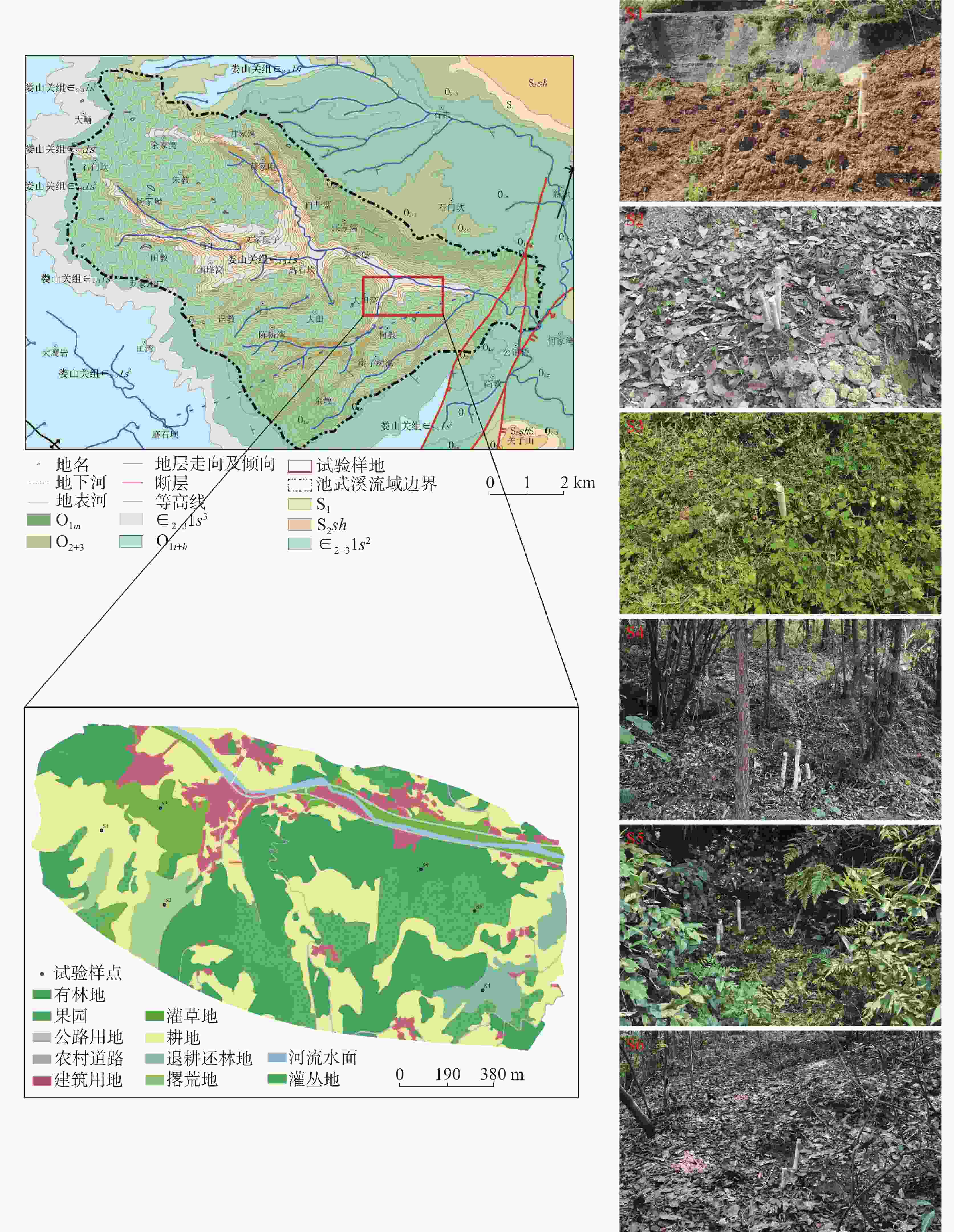
 下载:
下载:

